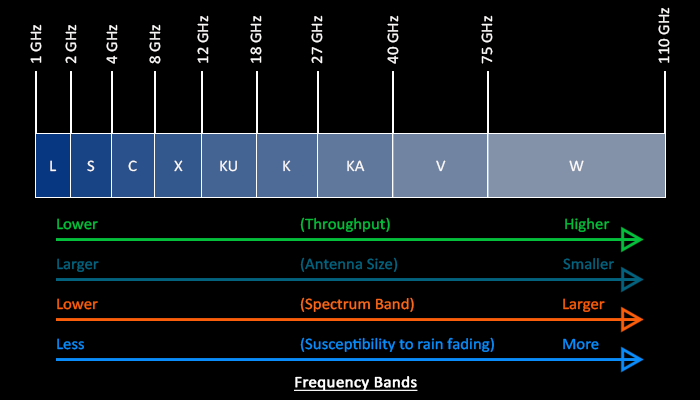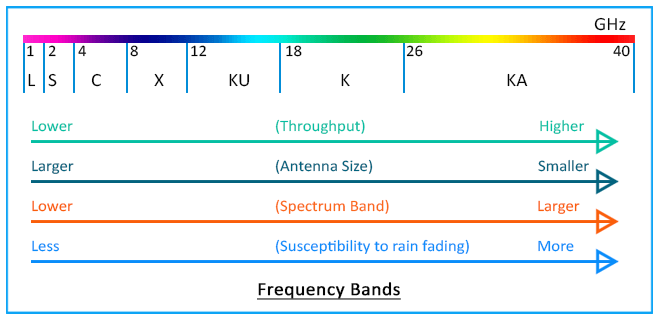Radar detectors search specific wavelength bands for police radar frequencies. The bands have different frequencies that they emit and are only detectable by these radar detectors. Radar detectors work by sensing drifting radiation from radar guns, lasers, and red light cameras and then alerting the driver of the presence of a radar. This enables drivers to adjust to the speed limit and avoid being booked for overspending. It also packs other significant functions that are beneficial to all types of drivers. What Are Radar Detector Bands?
Radar wavelengths operate on different frequencies. To get a specific wavelength, you need a device that can see those frequencies. This device is called a radar detector. The radar detector detects signals across the X, K, Ka, and Ku bands, although only some of these bands are actively functional. The K-band is the most popular of all the bands but is prone to false alerts. This is a result of its widespread usage in automatic doors, driver assistance package, and traffic signals. While the X-band is becoming obsolete, the Ka-band is new and gaining momentum.
Car owners are choosing radar detectors based on the bands they cover. You should learn the most used band in your city for higher efficiency before making a purchase.
Table of Contents
How Do Radars Detect Overspeeding
How do radars detect that your car is driving above the speed limit? The simple answer is that police officers point a radar gun at your vehicle or in your direction and your speed is registered on it. The gun beams a wave at your car and measures the change in frequency to determine speed when the signals are bounced back to the gun. Your speed is then displayed on the radar gun.
To block law enforcement from reading your vehicle’s speed, it is recommended that you install a radar detector with the right band. However, some police radars are equipped with Instant-On or RF that works when near your car. This is referred to by car owners as an ambush as it catches you unaware.
Older radar detectors failed as police radars developed. However, newer and more advanced radar detectors are equipped to detect features such and Instant-On laser speed guns. You can now use the inbuilt GPS to tag and store locations of notable police spots and redlight cameras.
What is Ka-Band
The Ka-band is the newest and most improved radio band being used by law enforcement. Its radar wave falls between 26.5-40Ghz. The Ka-band was adopted because of its high bandwidth, making it the fastest band on the market. Ka-Band also has the highest number of frequencies (5).
Aside from law enforcement, the Ka-band is also used for space exploration. This band has a narrow beam that produces low output and is undetectable from long range. A splendid advantage of the Ka-band stems from its law-enforcement monopoly. This reduces false alerts, so you can be sure that every alert you receive on this band is real.
You can find aftermath radar detectors with the Ka-band on the market to detect police radars on the same band.
What is X-band
The X-band is the oldest of all the bands. It falls between the frequency range of 7.0-11.2 GHz and is majorly utilized by police, military, and government departments tracking weather. The frequency of Police radars is usually at 10.5GHz.
So, you can be specific just as you’re specific with radio frequencies. The X-band is becoming obsolete, and as such is less congested. Most law enforcement has abandoned it for better-performing bands.
Although it has fewer false cases of false alerts, it is quite easier fot radar detectors to pick up, making it useless for law enforcement agencies looking to nab speed limit offenders.
Most advanced radar detectors combine the X-band with other well-performing bands g detect radars across a variety of frequencies.
What is K-Band
The K-band has a higher frequency range with a low output. This band falls between 18-27GHz and is a common band in the united states. Because of this, it has higher false alerts.
It also doesn’t detect long-range radars with efficiency, making them ineffective during highway drives. However, if the law enforcement within your city uses the K-band, then it’s imperative that you also buy a radar detector with the K-band.
To reduce the number of false alerts, we recommend that you buy advanced radar detectors with filters. Use the inbuilt GPS to also lockout places with high rates of false alarms. To deal with the low range limitation, we advise that your radar detector be equipped with high sensitivity and other well-performing bands.
Which Band Should You Choose
Choosing a radar band can be complex because of the distinct adaptation by various states. The different states in the United States use different radio bands, so it is pertinent that you familiarize yourself with the primary radio band of your locality.
However, if your driving route is the highway, then we recommend a high-frequency band but if you’re mainly in the city, then go for the city frequency option. Most advanced radar detectors, however, come with various radar bands.
How To Avoid False Alerts
Radar detector false alerts are a major menace to car owners. Constantly readjusting your speed only to find nothing is not only stressful but time-wasting. To avoid false alarms, we recommend that you constantly upgrade your radar detector to include the latest and most effective bands.
GPS Radar Detectors serve several important functions. With an inbuilt GPS, you can program your detector to lockout areas with a high frequency of false alerts. You can also hide your detector from the signals emitted by automatic doors and advanced safety systems in other cars.
Detector alerts are also displayed when you’re driving under the speed limit. This can be annoying as the alert is useless. Advanced radar detectors allow you to mute it when driving under the speed limit. Some detectors have an auto function that allows them to mute.
The sensitivity of your radar detector may also cause multiple false alerts. Advanced detectors have high sensitivity but are equipped with a switch that changes between city-mode and highway mode. City mode has a lower sensitivity as its major concern is radars within short range. However, highway mode has a longer sensitivity for picking out radars in far distance. It is recommended to set it to city mode as highway mode within a city causes multiple alerts.
Benefits Of Using Advanced Radar Detectors
Older radar detectors have limited functionality, and are ill-equipped to detect advanced radars being used by law enforcement. Advanced radars, on the other hand, are equipped for high detection, meaning they can detect radars from a rather long distance, alert the driver, and gives him/her enough time to adjust to the speed limit.
Car owners who have switched from outdated radar detectors have reported a reduction in false alerts. Advanced detectors are equipped with tools that help car owners avoid unnecessary false triggers.
Additionally, you’ll be enjoying new features like GPS and smartphone compatibility. It also has an audio notification system that alerts you without needing to look away from the road. According to the NHTSA, distracted driving caused the deaths of 2858 people in 2019, a significant increase from the previous year.
By keeping your eyes on the road, advanced radar detectors are actively preventing collisions and accidents.
The most alluring benefit of an advanced radar system is that it is a community-based platform. Other users can tell you what they’ve seen, thereby helping you avoid bad roads, heavy traffic, accidents, and police radars. However, it should be noted that not all police officers use radar detectors so don’t panic when your radar detector doesn’t go off beside a law enforcement officer.
Conclusively, the major radio bands are X, K, Ka. They work similarly but have different numbers of radio frequencies and




